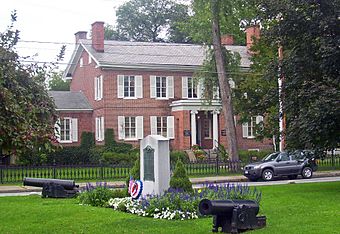Kinderhook Village District facts for kids
Quick facts for kids |
|
|
Kinderhook Village District
|
|

Main square looking north, 2008
|
|
| Location | Kinderhook, New York |
|---|---|
| Nearest city | Hudson |
| Area | 612 acres (248 ha) |
| Built | 1713-1850 |
| Architectural style | Federal, Greek Revival, Gothic Revival |
| NRHP reference No. | 74001227 |
| Added to NRHP | 1974 |
The Kinderhook Village District is a special historical area in the middle of Kinderhook, New York. It covers about 612 acres (248 ha) of land, including both developed areas and open spaces. This district is centered around US 9, a main road.
Many buildings in the district are from the 1700s and 1800s. Some of these buildings are connected to Martin Van Buren, who grew up in Kinderhook and later became the President. Because of its important history, the Kinderhook Village District was added to the National Register of Historic Places in 1974. This means it's recognized as a place worth protecting for future generations.
Contents
Where is the Kinderhook Village District?
The Kinderhook Village District covers most of the southeastern part of Kinderhook village. The Kinderhook Creek forms the eastern edge of the district, following the village's boundary.
Exploring the District's Layout
The district includes all the properties along several streets, such as Church, Hudson, Sylvester, and William streets, plus Jarvis and Maiden lanes, and Kinderknoll Drive. Most of these areas are homes where people live. The main village square, where Albany, Broad, Chatham, and Hudson streets meet, is a central spot.
A large part of the district to the east, near the creek, is open land. When the district was first listed as historic, it had about 250 buildings. Most of these buildings were built before the 1900s, showing how old and well-preserved the area is.
A Look Back: Kinderhook's History
Kinderhook's story began in the mid-1600s. At that time, Dutch farmers from Fort Orange (which is now Albany) moved south. They were looking for good land to farm. They found it along the bend of the Kinderhook Creek and built homes on a nearby bluff.
Early Buildings and Styles
One of the oldest buildings still standing is the Cornelius Schermerhorn House at 33 Broad Street. It was built in stages between 1713 and 1770. Other old homes, like the John Pruyn House (26 William Street), show early Dutch building styles with special gambrel roofs.
By 1763, Kinderhook had about 15 buildings and a Dutch Reformed Church. A new style of building arrived in 1774 with David van Schaack's brick home at 24 Broad Street. It was very grand, almost like a castle, with fancy features like a Palladian window. Many other homes in the village later copied these decorative touches.
Growth and New Architecture
The Albany Post Road, an important route that later became US 9, passed through Kinderhook. This road helped connect the village to the Hudson River at Stuyvesant. Farmers could then easily ship their crops to New York City. By 1813, Kinderhook had a small business center and many new homes built in the Federal style. The James Vanderpoel House at 16 Broad Street is a great example of this style.
The village grew very quickly in the 1820s. By 1836, just before Kinderhook officially became a village and during the time of the Van Buren Administration, it had 86 buildings. It was known as the main business center of the county. New buildings from this time showed off the popular Greek Revival and Carpenter Gothic styles. For example, the house at 29 Broad Street has pilasters (flat columns) around its entrance, typical of Greek Revival. St. Paul's Episcopal Church at 8 Sylvester Street is a good example of Gothic style.
Preserving History
After 1850, Kinderhook's growth slowed down. Martin Van Buren retired to his estate, Lindenwald, just south of the village. Also, new railroads bypassed Kinderhook, which meant less new development. Farming remained important, but the village didn't expand as much. Most new construction happened in the village center, like the commercial buildings on Hudson Street that replaced ones lost in an 1880 fire.
Because railroads didn't bring big changes, Kinderhook was able to keep its historic look and feel. This has continued into the 2000s, meaning the village still looks much like it did long ago.



